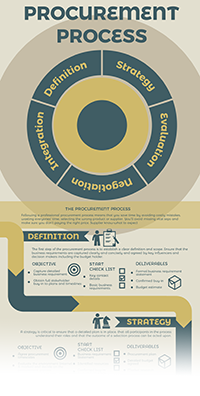
The Procurement Process
For every procurement project, a formal and professional procurement process will save time, save money and reduce risk. This article shows you how to hit the ground running with a procurement project and to deliver a professional result.
You will learn how you can use a professional process template to avoid the many pitfalls of a procurement project.
Click here for the PURCHASING PROCESS
The ultimate simple guide to the procurement process
This guide will help you to follow a formal procurement process:
- If you are responsible for a procurement project and you have limited access to expert procurement advice
- Your procurement project is not within the scope of your organization’s core business
- Your project is highly specialised and detailed technical knowledge combined with a little procurement expertise is better than expert procurement skills and no technical know-how.
Why Use a Formal Procurement Process?
A formal procurement process can be cumbersome or bureaucratic but for any procurement exercise, it is important to follow a few key steps. If you are not a procurement expert, you will make mistakes. No doubt you will learn from them but why learn from your mistakes when you can learn from someone else’s.
A procurement process template provides a model and a framework to work within to:
- Save you time; get the right solution to meet your business needs;
- Ensure you pay the right price (that’s the right price, not necessarily the lowest price!);
- Avoid overlooking vital steps that may come back to haunt you later.
By using a standard procurement process, you will find that suppliers will be familiar with the steps you take. They will know what to expect and will know that they are dealing with a professional organization.
A few words of warning about procurement methodologies
Every project is different. Some procurement projects are small and you may not require every step of a formal process. Alternatively, some projects are highly complex or regulated and a generic framework will not be appropriate or sufficient. Despite this, every procurement project follows the same broad process . The key thing to remember is to adapt the process to fit the project.
Check out other methodologies such as the CIPS Procurement and Supply Cycle.
What is Procurement?
The procurement process can be divided into five steps.
Define the business or sourcing need
You need to understand what the fundamental business requirement is. At this point, it is important to understand the difference between a requirement and a solution. For example, the business requirement may be to source some software to help to get information published on the company intranet. An item of software to publish information on the company intranet is a solution – not a requirement. The requirement is to be able to publish information on the intranet. It may be that an outsourced solution is a better option. A good procurement process can help.
Develop the Procurement Strategy
Depending on the scale of your project, there could be a very wide range of potential solutions and approaches to your business need and a number of ways of researching the market and selecting a supplier.
Supplier Selection and Evaluation in the Procurement Process
After researching the market and establishing your procurement approach, you need to evaluate the solutions available. This may involve a formal tender process or an on-line auction. You criteria for comparing different solutions and suppliers are critical. Weight the key criteria heavily and don’t attach too much importance to aspects that will have little impact on the solution.
Negotiation and award
Negotiate even when the supplier has been selected. This is not just about price. Think in terms of Total Cost of Ownership. A cheap product is not so cheap if the carriage costs are huge or if the maintenance contract is onerous.
Consider carefully the process by which the goods or services will be ordered and approved; how they will be delivered and returned if necessary? how the invoice process will work and on what terms payment will be made? Considering the whole Purchase to Pay process (P2P) at the outset can reduce costs and risk significantly
Induction and Integration
No goods or services should be ordered or delivered until the contract is signed. But this is not the end. It is vital that the supplier is properly integrated. The P2P (purchase to pay) process needs to be in place and need to be understood on both the buy-side and the supplier side. Any service levels that have been agreed need to be measured and KPIs put in place. Regular reviews should be established.
(See the Purchasing process)


